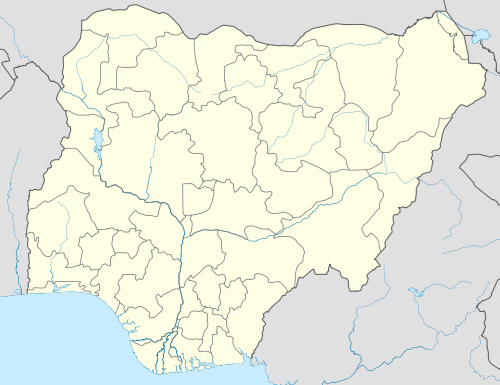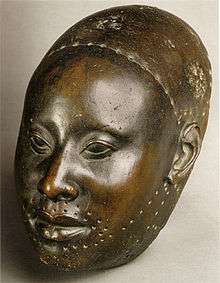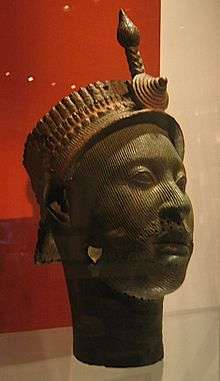Ife
| Ilé-Ifẹ̀ Ifè Oòyè | |
|---|---|
 Ilé-Ifẹ̀ | |
| Coordinates: 7°28′N 4°34′E / 7.467°N 4.567°E | |
| State | Osun |
| LGA(s) |
Ife Central Ife East Ife North Ife South |
| Government | |
| • Ọọni | Adeyeye Enitan Ogunwusi Ojaja II |
| • LGA Chairman, Ife Central | Taiwo Olaiya |
| • LGA Chairman, Ife North | Lanre Ogunyimika |
| • LGA Chairman , Ife South | Timothy Fayemi |
| • LGA Chairman, Ife East | Tajudeen Lawal |
| Area | |
| • Total | 1,791 km2 (692 sq mi) |
| Population (2006)[1] | |
| • Total | 509,035 |
| • Density | 280/km2 (740/sq mi) |
| Climate | Aw |
Ife (Yoruba: Ifè, also Ilé-Ifẹ̀) is an ancient Yoruba city in south-western Nigeria. The city is located in the present day Osun State. Ife is about 218 kilometres (135 mi) northeast of Lagos.[2]
History

Mythic origin of Ife: Creation of the world
According to Yoruba religion, Olodumare, the Supreme God, ordered Obatala to create the earth but on his way he found palm wine which he drank and became intoxicated. Therefore, the younger brother of the latter, Oduduwa, took the three items of creation from him, climbed down from the heavens on a chain and threw a handful of earth on the primordial ocean, then put a cockerel on it so that it would scatter the earth, thus creating the land on which Ile Ife would be built.[3] Oduduwa planted a palm nut in a hole in the newly formed land and from there sprang a great tree with sixteen branches, a symbolic representation of the clans of the early Ife city-state. The usurpation of creation by Oduduwa gave rise to the ever lasting conflict between him and his elder brother Obatala, which is still re-enacted in the modern era by the cult groups of the two clans during the Itapa New Year festival.[4] On account of his creation of the world Oduduwa became the ancestor of the first divine king of the Yoruba, while Obatala is believed to have created the first Yoruba people out of clay. The meaning of the word "ife" in Yoruba is "expansion"; "Ile-Ife" is therefore in reference to the myth of origin "The Land of Expansion".
Origin of the regional states: Dispersal from the holy city
Oduduwa had sons, daughters, and a grandson who went on to found their own kingdoms and empires, namely Ila Orangun, Owu, Ketu, Sabe, Popo and Oyo. Oranmiyan, Oduduwa's last born, was one of his father's principal ministers and overseer of the nascent Edo empire after Oduduwa granted the plea of the Edo people for his governance. When Oranmiyan decided to go back to Ile Ife after a period of service in Benin, he left behind a child named Eweka that he had in the interim with an indigenous princess. The young boy went on to become the first legitimate ruler of the second Edo dynasty that has ruled what is now Benin from that day to this. Oranmiyan later went on to found the Oyo Empire that stretched at its height from the western banks of the river Niger to the Eastern banks of the river Volta. It would serve as one of the most powerful of Africa's medieval states prior to its collapse in the 19th century.
Traditional setting
The King (Ooni)
The Oòni (or king) of Ife claims direct descent from Oduduwa, and is counted first among the Yoruba kings. He is traditionally considered the 401st spirit (Orisha), the only one that speaks. In fact, the royal dynasty of Ife traces its origin back to the founding of the city more than ten thousand years before the birth of Jesus Christ. The present ruler is Adeyeye Ogunwusi, styled His Imperial Majesty by his subjects. The Ooni ascended his throne in 2015. Following the formation of the Yoruba Orisha Congress in 1986, the Ooni acquired an international status the likes of which the holders of his title hadn't had since the city's colonisation by the British. Nationally he had always been prominent amongst the Federal Republic of Nigeria's company of royal Obas, being regarded as the chief priest and custodian of the holy city of all the Yorubas.[5] In former times, the palace of the Oni of Ife was a structure built of authentic enameled bricks, decorated with artistic porcelain tiles and all sorts of ornaments.[6] The current Ooni, Oba Adeyeye Enitan Ogunwusi Ojaja II, Ooni of Ife, (born October 17, 1974) is a Nigerian accountant and the 51st Ooni of Ife. He succeeded the late Oba Okunade Sijuwade who died on July 28, 2015.
Cults for the spirits
Ife is well known as the city of 401 deities. It is said that every day of the year the traditional worshippers celebrate a festival of one of these deities. Often the festivals extend over more than one day and they involve both priestly activities in the palace and theatrical dramatisations in the rest of the kingdom. Historically the King only appeared in public during the annual Olojo festival; other important festivals here include the Itapa festival for Obatala and Obameri, the Edi festival for Moremi Ajasoro, and the Igare masqueraders.[7]
Art history

Kings and Gods were often depicted with large heads because the artists believed that the Ase was held in the head, the Ase being the inner power and energy of a person. Both historic figures of Ife and the offices associated with them are represented. One of the best documented among this is the early king Obalufon II who is said to have invented bronze casting and is honored in the form of a naturalistic copper life-size mask. [8]
The city was a settlement of substantial size between the 12th and 14th centuries, with houses featuring potsherd pavements. Ilé-Ifè is known worldwide for its ancient and naturalistic bronze, stone and terracotta sculptures, which reached their peak of artistic expression between 1200 and 1400 A.D. In the period around 1300 C.E. the artists at Ife developed a refined and naturalistic sculptural tradition in terracotta, stone and copper alloy - copper, brass, and bronze many of which appear to have been created under the patronage of King Obalufon II, the man who today is identified as the Yoruba patron deity of brass casting, weaving and regalia.[9] After this period, production declined as political and economic power shifted to the nearby kingdom of Benin which, like the Yoruba kingdom of Oyo, developed into a major empire.
Bronze and terracotta art created by this civilization are significant examples of naturalism in pre-colonial African art and are distinguished by their variations in regalia, facial marking patterns, and body proportions. Ancient Ife also was famous for its glass beads which have been found at sites as far away as Mali, Mauritania, and Ghana.
Government
The main city of Ife is divided into two local government areas: Ife East, headquartered at Oke-ogbo and Ife central at Ajebandele area of the city. Both local governments are composed of a total of 21 political wards. The city has an estimated population of 355,813 people.[10]
Geography
Ife is located within the Tropical savanna climate zone of West Africa. It has average rainfall of 1000-1250mm usually from March to October and a mean relative humidity of 75% to 100%. Ife is west of the city of Ibadan and connected to it through the Ife-Ibadan highway; Ife is also 40 km from Osogbo and has road networks to other cities such as Ede, Ondo and Ilesha.
There is the Opa river and reservoir that serves as a water treatment facility for OAU college.
Economy
Ife has a few open markets such as Oja Titun or Odo-gbe market with about 1500 shops.
Exhibition
A major exhibition entitled Kingdom of Ife: Sculptures of West Africa, displaying works of art found in Ife and the surrounding area, was held in the British Museum from 4 March to 4 July 2010.[11]
See also
Notes
- ↑ "FEDERAL REPUBLIC OF NIGERIA : 2006 Population Census" (PDF). Web.archive.org. Archived from the original (PDF) on 5 March 2012. Retrieved 25 July 2016.
- ↑ "World: Africa Arrests after Nigerian cult killings." BBC. Monday July 12, 1999. Retrieved on October 31, 2011.
- ↑ Bascom, Yoruba, p. 10; Stride, Ifeka: "Peoples and Empires", p. 290.
- ↑ Olupona, 201 Gods, 144-173; Lange, Ancient Kingdoms, 347-366; idem., "Preservation", 130-1.
- ↑ Olupona, 201 Gods, 94.
- ↑ Cheikh Anta Diop's Precolonial Black Africa, pg. 203
- ↑ Walsh, "Edi festival", 231-8; Bascom, "Olojo", 64-72; Lange, Ancient Kingdoms, 358-366; Olupona, 201 Gods'.
- ↑ Blier, Suzanne Preston. "Art in Ancient Ife Birthplace of the Yoruba" (PDF). Academia.edu. African Arts 2012. Retrieved April 7, 2015.
- ↑ Blier, Suzanne Preston (2015). Art and Risk in Ancient Yoruba: Ife History, Politics, and Identity c. 1300. Cambridge University Press. ISBN 978-1107021662.
- ↑ YOADE, Adewale Olufunlola. "PHYSICAL CHARACTERISTICS OF CORE AREA OF ILE-IFE, NIGERIA." Annals Of The University Of Oradea, Geography Series / Analele Universitatii Din Oradea, Seria Geografie 25, no. 2 (December 2015): 137-147. Academic Search Premier, EBSCOhost (accessed March 2, 2016)
- ↑ Britishmuseum.org
References
- Olubunmi, A.O. The Rise and Fall of The Yoruba Race 10,000BC-1960AD, The 199 Publishing Palace ISBN 978-2457-38-8
- ---: On Ijesa Racial Purity, The 199 Publishing Palace ISBN 978-2458-17-1
- Akinjogbin, I. A. (Hg.): The Cradle of a Race: Ife from the Beginning to 1980, Lagos 1992 (The book also has chapters on the present religious situation in the town).
- Blier,Suzanne Preston. Art and Risk in Ancient Yoruba: Ife History, Power, and Identity c.1300, Cambridge University Press 2015. ISBN 978-1107021662.
- Blier, Suzanne Preston. "Art in Ancient Ife Birthplace of the Yoruba" African Arts 2012
- Bascom, William: The Yoruba of south-western Nigeria, New York 1969 (The book mainly deals with Ife).
- --- "The Olojo festival at Ife, 1937", in: A. Falassi (ed.), Time out of Time. Essays on the Festival, Albuquerque, 1987, 62-73.
- Frobenius, Leo, The Voice of Africa, London 1913 (Frobenius stayed for nearly two months in Ife, in 1910-11).
- Johnson, Samuel: History of the Yorubas, London 1921.
- Lange, Dierk: "The dying and the rising God in the New Year Festival of Ife", in: Lange, Ancient Kingdoms of West Africa, Dettelbach 2004, pp. 343–376.
- ---: "Preservation of Canaanite creation culture in Ife", in: H.-P. Hahn and G. Spittler (eds.), Between Resistance and Expansion, Münster 2004, 125-158.
- ---: "Origin of the Yoruba and 'Lost Tribes of Israel'", Anthropos, 106, 2011, 579-595.
- Ogunyemi, Yemi D. (Yemi D. Prince), The Oral Traditions in Ile-Ife, ISBN 978-1-933146-65-2, Academica Press, 2009, Palo Alto, USA.
- ---: The Aura of Yoruba Philosophy, Religion and Literature, ISBN 0-9652860-4-5, Diaspora Press of America, 2003, Boston, USA.
- ---: Introduction to Yoruba Philosophy, Religion and Literature, ISBN 1-890157-14-7, Athelia Henrietta Press, 1998, New York, USA.
- ---: The Covenant of the Earth--Yoruba Religious & Philosophical Narratives, ISBN 1-890157-15-5, Athelia Henrietta Press, 1998, New York, USA.
- Olupona, Jacob K.: City of 201 Gods: Ile-Ife in Time, Space and Imagination, Berkeley 2011.
- Stride, G.T. and C. Ifeka: "Peoples and Empires of West Africa: West Africa in History 1000 - 1800", New York 1971.
- Walsh, M.J., "The Edi festival at Ile Ife", African affairs, 47 (1948), 231-8.
- Willett, Frank: Ife in the History of West African Sculpture, London 1967 (The book also deals with some oral traditions of Ile-Ife).
- Wyndham, John: "The creation", Man, 19 (1919), 107-8.
External links
- Homepage of the Ooni of Ife
- The Story of Africa: Ife and Benin BBC page on Ife
- Yoruba Myths Por Ulli Beie
Coordinates: 7°28′N 4°34′E / 7.467°N 4.567°E